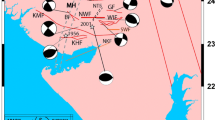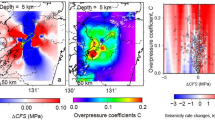Abstract
The role of fluid injection on the occurrence and migration path for the aftershocks of 2004 Sumatra earthquake (Mw 9.3) and January 2005 Andaman earthquake swarm within the aftershock sequence is investigated here from the viewpoint of pore fluid diffusion process. The Sumatra earthquake created a regionally extensive crustal rupture plane exceeding 1,200 km length below the Andaman Sea. The r–t plots (Shapiro et al. 1997) are constructed for these aftershocks in order to examine the role of poroelastic effects as rupturing progressed with time. Their main results are as follows: the r–t plot corresponding to first 3 h of aftershock activity (when only 44 events of mb ≥ 4.5 originated) reveals that 95% of the data points occurred below the modelled parabola with relatively high D value of 20 m2/s, whereas a significantly low D value of 3.5 m2/s characterises the aftershock activity for the first 24 h (when 420 events of mb ≥ 4.0 occurred). Here, the Coulomb stress was transferred from the main shock with a rapid imposition of normal stress, thus inducing the pore-pressure change that started diminishing almost immediately by fluid diffusion, at a rate, defined by the diminishing D value. The modelling results for fault seismicity at far off distances from the main epicentre are interpreted here as potential indicators for large-scale sub-seabed rupturing—consequent to stress changes induced by bending of the Indian Ocean plate. Bathymetric slopes under the Andaman subduction zone are particularly amenable to sub-marine slides where crustal E–W hinge faults inferred seismically cut across the N–S trending regional thrust and strike-slip faults. Seabed rupturing appears to allow deep-slab hydration in these areas, producing pressure gradients along the normal faults. These features are important since they can herald marine geohazards in the Andaman region.






Similar content being viewed by others
References
Antonioli A, Piccinini D, Chiaraluce L, Cocco M (2005) Fluid flow and seismicity pattern: Evidence from the 1997 Umbria-Marche (central Italy) seismic sequence. Geophys Res Lett 32:L10311
Billen MI (2009) Soaking slabs. Nat Geosci 2:744–746
Bosl WJ, Nur A (2002) Aftershocks and pore fluid diffusion following the 1992 Landers earthquake. J Geophys Res 107(B12):2366
Dasgupta S, Mukhopadhyay M, Bhattacharya A, Jana TK (2003) The geometry of the Burmese- Andaman subducting lithosphere. J Seismol 7:155–174
Dasgupta S, Mukhopadhyay B, Acharyya A (2005) Aftershock propagation characteristics during the first three hours following the 26 December 2004 Sumatra- Andaman earthquake. Gondwana Res 8:585–588
Dasgupta S, Mukhopadhyay B, Bhattacharya A (2007) Seismicity pattern in north Sumatra- Great Nicobar Region: in search of precursor for the 26 December 2004 earthquake. J Earth Syst Sci 116(3):215–223
Faccenda M, Gerya TV, Burlini L (2009) Deep slab hydration induced by bending-related variations in tectonic pressure. Nat Geosci 2:790–793
Krüger F, Ohrnberger M (2005) Tracking the rupture of the Mw = 9.3 Sumatra earthquake over 1, 150 km at teleseismic distance. Nature 435:937–939
Kuempel H (1991) Poroelasticity: parameters reviewed. Geophys J Int 105:783–799
Lay T, Kanamori H, Ammon CJ, Nettles M, Ward SN, Aster RC, Beck SL, Bilek SL, Bredzinski R, Butler R, Deshon HR, Ekstrom G, Satake K, Sipkin S (2005) The great Sumatra–Andaman earthquake of 26 December 2004. Science 308:1127–1132
Mukhopadhyay B, Dasgupta S (2008) Swarms in Andaman Sea, India–a seism tectonic analysis. Acta Geophysica 56(4):1000–1014. doi:10.2478/s11600-008-0039-5
Mukhopadhyay B, Acharyya A, Bhattacharya A, Dasgupta S, Sengupta SR (2009) Revisiting the Andaman subduction lithosphere following the 26 December 2004 Sumatra earthquake. Indian J Geosci 63(1):1–10
Mukhopadhyay B, Acharyya A, Mukhopadhyay M, Dasgupta S (2010) Relationship between earthquake swarm, rifting history, magmatism and pore pressure diffusion–an example from South Andaman Sea, India. J Geol Soc India 76:164–170
Noir J, Jacques E, Bekri S, Alder PM, Tapponier P, King GCP (1997) Fluid flow triggered migration of events in the 1989 Dobi earthquake sequence of Central Afar. Geophys Res Lett 24:2335–2338
Parotidis M, Rothert E, Shapiro SA (2003) Pore-pressure diffusion: a possible triggering mechanism for the earthquake swarms 2000 in Vogtland/NW Bohemia, Central Europe. Geophy Res Lett 30(20):2075. doi:10.1029/2003GL018110
Sandwell DT, Smith WHF (2009) Global marine gravity data from retracted Geosat and ERS-1 altimetry: ridge segmentation versus spreading rate. J Geophys Res 114:B01411. doi:10.1029/2008JB006008
Shapiro SA, Huenges E, Borm G (1997) Estimating the crust permeability from fluid-injection-induced seismic emission at the KTB site. Geophys J Int 131:F15–F18
Shapiro SA, Audigane P, Royer JJ (1999) Large scale in situ permeability tensor of rocks from induced microseismicity. Geophys J Int 137:207–213
Shapiro SA, Rothert E, Rath V, Rindschwentner J (2002) Characterization of fluid transport properties of reservoirs using induced microseismicity. Geophysics 67(1):212–220
Shapiro SA, Patzig R, Rothert E, Rindschwentner J (2003) Triggering of seismicity by pore pressure perturbations: permeability related signatures of the phenomenon. Pure Appl Geophys 160:1051–1066
Smith WHF, Sandwell DT (1997) Global seafloor topography from satellite altimetry and ship depth soundings. Science 277:1957–1962
Stein S, Okal EA (2005) Speed and size of the Sumatra earthquake. Nature 434:581–582
Sultan N, Cattaneo A, Sibuet JC, Schneider JL, The Sumatra Aftershocks Team (2009) Deep sea in situ excess pore pressure and sediment deformation off NW Sumatra and its relation with the December 26, 2004 Great Sumatra- Andaman earthquake. Int J Earth Sci 98(4):823–837
Tappin DR, Mcneil LC, Henstock T, Mosher D (2007) Mass wasting process—off shore Sumatra. In: Lykousis V, Sakellarious D, Locat J (eds) Submarine mass movements and their consequences- 3rd International Symposium. Springer, Berlin, pp 327–336
Wang H (2000) Theory of linear poroelasticity. Princeton University Press, Princeton
Acknowledgments
We thank Dr. V. Schenk, Editor in Chief for his valuable comments on an earlier version of the manuscript. We are also thankful to two erudite anonymous reviewers whose suggestions have been of good help.
Author information
Authors and Affiliations
Corresponding author
Rights and permissions
About this article
Cite this article
Mukhopadhyay, B., Dasgupta, S., Fnais, M. et al. Modelling the pore fluid diffusion process in aftershock initiation for 2004 Sumatra earthquake: implications for marine geohazard estimation in the Andaman region. Nat Hazards 57, 39–49 (2011). https://doi.org/10.1007/s11069-011-9779-7
Received:
Accepted:
Published:
Issue Date:
DOI: https://doi.org/10.1007/s11069-011-9779-7




